
Victorian architecture is a series of architectural revival styles in the mid-to-late 19th century. Victorian refers to the reign of Queen Victoria (1837–1901), called the Victorian era, during which period the styles known as Victorian were used in construction. However, many elements of what is typically termed "Victorian" architecture did not become popular until later in Victoria's reign, roughly from 1850 and later. The styles often included interpretations and eclectic revivals of historic styles (see Historicism). The name represents the British and French custom of naming architectural styles for a reigning monarch. Within this naming and classification scheme, it followed Georgian architecture and later Regency architecture and was succeeded by Edwardian architecture.

Bernard Ralph Maybeck was an American architect in the Arts and Crafts Movement of the early 20th century. He was an instructor at University of California, Berkeley. Most of his major buildings were in the San Francisco Bay Area.
Robert Cary Long Jr. (1810–1849) was the son of a late 18th Century - early 19th Century famous architect Robert Cary Long Sr. of Baltimore, Maryland and was himself a well-known 19th Century architect. Like his father, Cary was based in Baltimore.

Carpenter Gothic, also sometimes called Carpenter's Gothic or Rural Gothic, is a North American architectural style-designation for an application of Gothic Revival architectural detailing and picturesque massing applied to wooden structures built by house-carpenters. The abundance of North American timber and the carpenter-built vernacular architectures based upon it made a picturesque improvisation upon Gothic a natural evolution. Carpenter Gothic improvises upon features that were carved in stone in authentic Gothic architecture, whether original or in more scholarly revival styles; however, in the absence of the restraining influence of genuine Gothic structures, the style was freed to improvise and emphasize charm and quaintness rather than fidelity to received models. The genre received its impetus from the publication by Alexander Jackson Davis of Rural Residences and from detailed plans and elevations in publications by Andrew Jackson Downing.

Calvary Presbyterian Church is a Victorian Gothic church located in the Marquette University district of downtown Milwaukee, Wisconsin. It has been listed on the National Register of Historic Places since 1986.
The San Francisco Theological Seminary (SFTS) is a seminary in San Anselmo, California with historic ties to the Presbyterian Church (U.S.A.). SFTS became embedded in a new Graduate School of Theology of the University of Redlands in 2019. It was founded by the Synod of California in 1871.

Church Street United Methodist Church is a United Methodist church located on Henley Street in downtown Knoxville, Tennessee. The church building is considered a Knoxville landmark and is listed on the National Register of Historic Places.

Frederick Clarke Withers was an English architect in America, especially renowned for his Gothic Revival ecclesiastical designs. For portions of his professional career, he partnered with fellow immigrant Calvert Vaux; both worked in the office of Andrew Jackson Downing in Newburgh, New York, where they began their careers following Downing's accidental death. Withers greatly participated in the introduction of the High Victorian Gothic style to the United States.

The Fort Street Presbyterian Church is located at 631 West Fort Street in Detroit, Michigan. It was constructed in 1855, and completely rebuilt in 1877. The church was listed on the National Register of Historic Places and designated a Michigan State Historic Site in 1971. Its steeple stands 265 ft (81 m), making it one of the tallest churches in the United States.
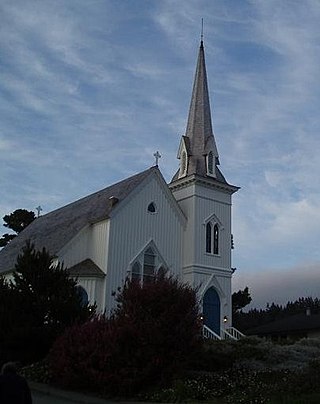
The Mendocino Presbyterian Church is an historic Carpenter Gothic-style Presbyterian church building located at 44831 Main Street, in Mendocino, California. Built of coast redwood, it sits on the Mendocino headlands overlooking the Pacific Ocean; its board and batten exterior walls, tall side-entrance bell tower, steep gabled roof and lancet windows are typical of many Carpenter Gothic churches. Its stained glass windows were made by local stained glass artist Leone McNeil Zimmer.

The Sea and Land Church is located at 61 Henry Street and Market Street in the Chinatown and Two Bridges neighborhoods of Manhattan in New York City. It was built in 1819 of Manhattan schist, and added to the National Register of Historic Places on April 9, 1980. The structure is one of the three Georgian Gothic Revival churches on the Lower East Side with the other ones being St. Augustine's Chapel and the Church of the Transfiguration. It is also the second oldest church building in New York City.

First Presbyterian Church, also known as the Calvary Temple Evangelical Church and St. Patrick's Priory Church, is a historic church at 946 Market Street in Parkersburg, Wood County, West Virginia. It was built in 1894, and is a two-story, brick and stone church building in a combined Romanesque / Gothic Revival style. It features a corner bell tower.

First Presbyterian Church is a Presbyterian Church (USA) church located in Muscatine, Iowa, United States. It, along with the attached Sunday School building, were listed on the National Register of Historic Places in 1977.
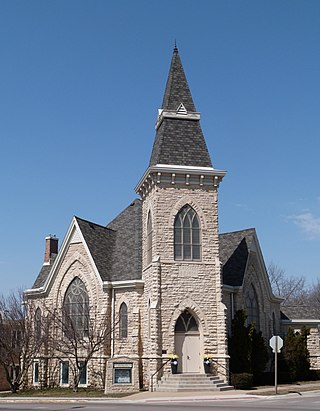
First Presbyterian Church is located in Marion, Iowa, United States. It was listed on the National Register of Historic Places in 1992.
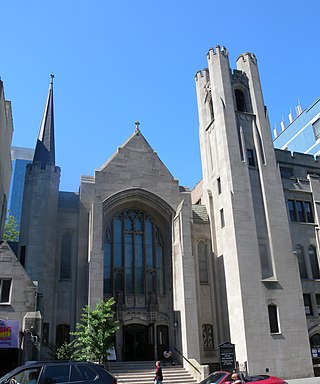
Saint Luke's Lutheran Church, once known as The German Evangelical Lutheran Saint Luke's Church, is a historic Lutheran church located on Restaurant Row at 308 West 46th Street between Eighth and Ninth Avenues in the Theater District of Manhattan, New York City.

The Episcopal Church of the Good Shepherd is an historic Carpenter Gothic style Episcopal church building located at 1001 Hearst Street at Ninth Street in Berkeley, California. Built in 1878, it was designed in the Carpenter Gothic style of architecture by architect Charles L. Bugbee who was associated with his father Samuel C. Bugbee in the San Francisco firm of S. C. Bugbee & Son. Charles L. Bugbee patterned it after the Carpenter Gothic style Mendocino Presbyterian Church, which the firm had designed in 1867. While all of the Mendocino church's exterior walls are of board and batten siding, only the upper walls of Good Shepherd are board and batten while the lower walls are of Dutch lap weatherboarding. Both churches feature tall side-entrance bell towers, steep gabled roofs and lancet windows, but according to writer Daniella Thompson: "...the Church of the Good Shepherd is considerably more ornate and playful than its severe Presbyterian model, ..." On December 15, 1975, Good Shepherd became the second building in Berkeley to be named an Historic Landmark. On December 1, 1986, it was added to the National Register of Historic Places as the Church of the Good Shepherd-Episcopal.

The Julia Morgan Theater, located in the former St. John's Presbyterian Church, is a historic building in Berkeley, California designed by architect Julia Morgan. The wooden building at 2640 College Avenue is built in the American Craftsman style with an exterior wood-shingle finish known as Berkeley Brown Shingle. The church building was desanctified and sold when the congregation moved to a new building in 1974. It now houses the Berkeley Playhouse. The structure is #8 on the city of Berkeley's list of historic landmarks. In 1975 it was added to the National Register of Historic Places.

Calvary Presbyterian Church is a historic Presbyterian church in San Francisco, California located in Pacific Heights at the corner of Fillmore Street and Jackson Street, and is a congregation that is part of the Presbyterian Church (USA).
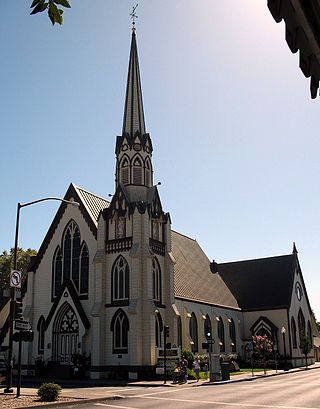
First Presbyterian Church is a historic church at 1333 3rd Street in Napa, California.
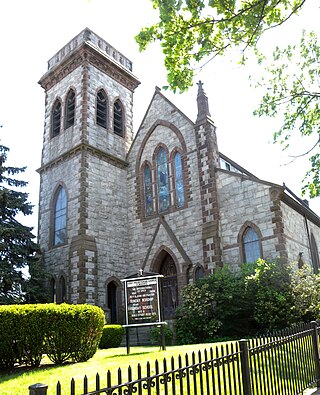
The First Presbyterian Church of Newtown is a historic Presbyterian church in the Elmhurst neighborhood of Queens in New York City. The church complex is composed of the main church, a parish hall, and a manse. The current complex at 54th Avenue, between Seabury Street and Queens Boulevard, is the fifth church complex built for the congregation.





















